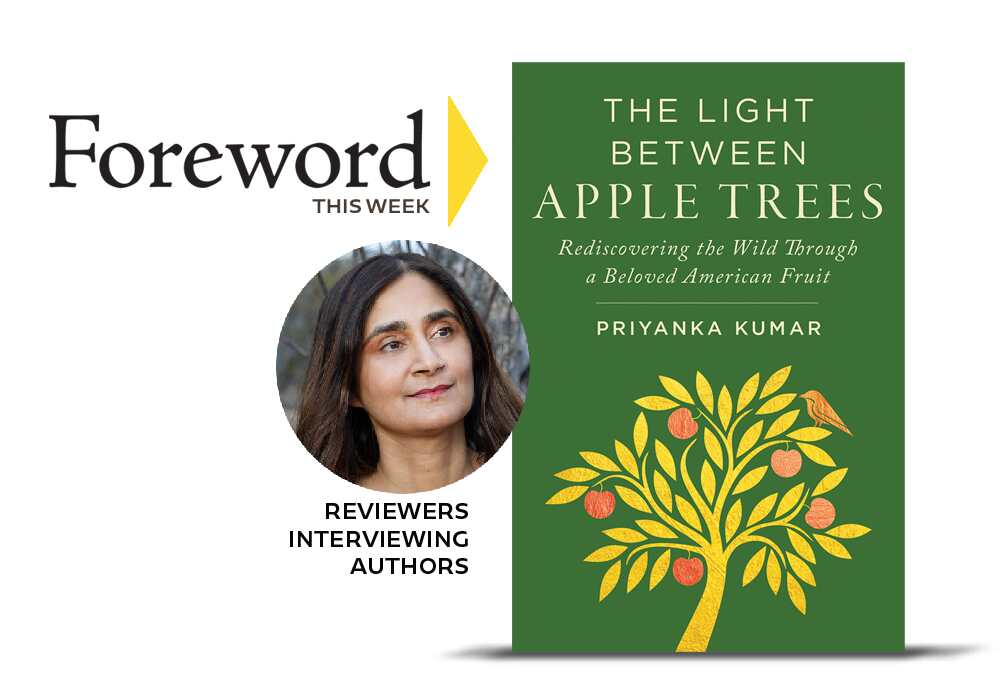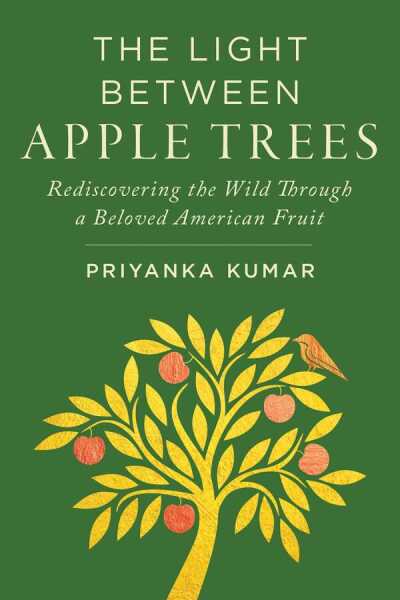Reviewer Kristen Rabe Interviews Priyanka Kumar, Author of The Light Between Apple Trees: Rediscovering the Wild Through a Beloved American Fruit

A writer we’ve long adored is back with an enchanting history of apples—and while Priyanka Kumar doesn’t quite cover all 16,000 known apple varieties in The Light Between Apple Trees, you will be hard pressed to keep from rewilding your backyard with enigmatic heirloom apple trees like Russian Giant Crab, Black Oxford, Rome Beauty, Winter Banana, and one of Thomas Jefferson’s favorites, the Newtown Pippin after giving the book a go.

Fresh from penning her review of the book for Foreword’s September/October issue, Kristen Rabe connected with Priyanka for the following conversation. If compelling history projects are your reading passion, these recent INDIES winners are well worth your attention.
In this book, you describe your family’s discovery of several historic and feral apple trees near your home in Santa Fe. The arid Southwest may seem like an unlikely place for apple orchards. What drew you to the history of apples in this country? How did your discovery help inspire this book?
Several years back while hiking in Santa Fe, I came upon a private orchard—and felt magnetized. I circled back to the area regularly to understand why it had this powerful draw. Two things happened: I discovered feral apple trees growing in the area; and a powerful childhood memory called out to me. As a child I’d lived in the foothills of the Himalayas, and some of those years were spent in the mountains surrounded by mature apple trees. Little did I know then that those trees had taken root in my heart!
To examine my love of apple trees, I went on a yearslong journey that triggered a strong connection with those who planted apple trees in America hundreds of years ago. Even in the 19th century, our country grew an astounding number of apple varieties. Of the 16,000 apple varieties once celebrated in America, however, scarcely a fifth remain accessible. Industrialization contributed to a tragic loss in apple biodiversity, and we lost our intimate connection to orchards.
Apple trees are living portals into science and history. I researched areas across the country where historic varieties persist, despite neglect. My field work led me to a transformative realization: An apple is not simply a fruit. The apple has a gravitas that can take us places where we might otherwise never go. I wrote initially to make sense of my discoveries. A friend said that the first pages read like music, like I was making music. So I went on making music, and the book took shape. I wanted to write a book that would distill the richness that biodiverse orchards once offered—and show that they can still infuse us with joy.
The book includes profiles of significant and historic apple growing regions, from Virginia to Oregon. What did you observe during your tours of notable apple orchards?
While researching the book, I visited one of the oldest orchards in the area where I live. It felt like I had arrived in New Mexico’s version of Thoreau’s Walden. I wanted to sink into this space where the stucco house blended in with the land and the resident heron flew across a mossy pond. The sun filtered through the apple trees, and I saw a line of ancient hills beyond. I felt at home. Such light and joy poured into me from between the apple trees. The book’s title distills how I have found poetry and a thrilling current of life among historic trees.
The apple’s history in America, over four centuries, is very compelling. I tasted apples in the oldest private orchard in our country, and then I stayed for a month in Monticello. There I researched Thomas Jefferson’s North and South orchards, where he once grew a dizzying number of fruit varieties. Jefferson is a complicated figure, but after I closely observed his grounds, I gained a window into the way he thought about the natural world. Interestingly, I’m growing in my garden some of the same apple varieties Jefferson grew, and I also understand his many frustrations.
What are your favorite varieties of heirloom apples? How hard are they to find today?
I love visually enthralling apples like Hidden Rose and Russian Giant Crab. I recently shared some Hidden Rose apples with my neighbors, who grow roses. People always light up when I cut open this variety; they are beautiful apples with pink flesh. There’s also the Black Oxford, which has green-tinged flesh and a faint taste of pistachio.
I grow some of the older apple varieties after grafting them from existing trees. For instance, I am growing the Newtown Pippin, which Jefferson liked to brag about. I’ll also find them in abandoned groves or from dedicated orchardists. Our local farmers’ market will sometimes carry a lovely old variety like Winter Banana or Rome Beauty. I buy what I can and divide my loot into portions for people who’ve shared apples with me and for kids who’ve not yet experienced the wonder of apples.
Talk about your encounters with the natural world as a child growing up in the Himalayan foothills. How did those experiences influence your commitment to promoting biodiversity today?
Mountains were my friends, and I had conversations with them as I walked to school in the mornings. If snow streaked across their peaks in a certain way, I would think the mountains were frowning at me. I was aware of the diversity and abundance of wildflowers from a very early age. My method of botanizing included tasting the flowers. Nature was my playground; I had very few toys. Growing up with all this beauty, I internalized it. Today, when I’m in an urban landscape, I see how more biodiversity would enrich our lives and ensure the integrity of ecosystems, which are like a multitude of wheels keeping our planet running.
You write about your hope to visit the wild forests of Kazakhstan. What’s so compelling about those forests?
Apple trees are wilder than we imagine. They evolved with bears and, in the late Pleistocene, megafaunal mammals dispersed them around the earth. Tapping into the apple’s relationships with bears and birds today can be a surprising conduit back to the wild. I studied the roots of the apple—its birthplace in Kazakhstan—and naturally wanted to visit. For reasons I detail in the book, this dream was not realized.
The cultivar apple is both iconic and familiar, although its true origins were long shrouded in mystery. Many scientists believed that Malus sieversii, the wild apple that still grows along the flanks of Kazakhstan’s Tian Shan mountains, is the primary ancestor of our cultivar apple, but unanswered questions persisted. For starters, how did humans arrive at the cultivated apple with more ten thousand varieties, simply from Malus sieversii? In the book, I take us on the scientific roller coaster that revealed the true origins of the apple.
You note the importance to your family of experiencing “micro-wilderness” areas. What advice do you have for those interested in reconnecting with nature?
Sociologists caution that many of us are retreating too far into digital solitude. This phenomenon, underway right now, is changing how we interact with each other—and with nature. Human communities are fraying, and our relationship with nature has become impoverished. A recent study estimated that our connection to nature has declined by 60 percent over the last two hundred years. When we lose our personal connection to nature, we more easily overlook the loss of biodiversity among insect, bird, and tree communities—at our own peril.
On my hikes, I’ve found feral and historic apple trees in all kinds of unexpected places—the spaces between where we live and work and where nature and forests are circumscribed. I call these spaces the “micro-wild.” We can reap significant benefits from spending time there. I also encourage people to garden as though they are creating their very own micro-wild.
Apple trees have a magnetic power that can draw us back into nature. They come in magically diverse shapes, sizes, colors, and flesh. Some of the most entrancing orchards I researched—where I felt like Alice in Wonderland—were nestled against a forest. The same principles that lead to healthy orchards—biodiverse flora, living soil, and pollinator diversity—also make for healthy forests. So, orchards not only bring us physically closer to nature, but they also help us better understand our forests.
Kristen Rabe
